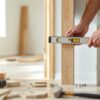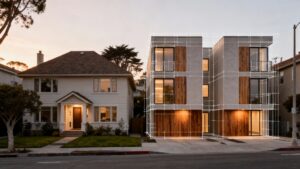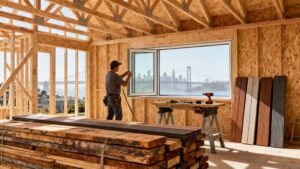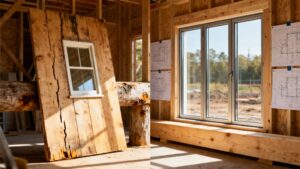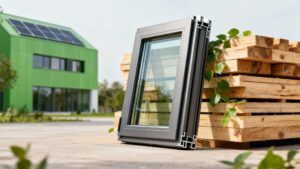If you're looking at old, drafty windows and wondering if a replacement is worth the investment, you've come to the right place. Replacing windows in the Bay Area is one of the smartest upgrades you can make to your home. It boosts value, comfort, and energy efficiency all at once.
Benefits of Energy-Efficient Windows in the Bay Area
Swapping out windows is a big decision, but here in the Bay Area, it's often necessary. Our unique microclimates, from the damp fog in San Francisco to the summer sun in Oakland, put serious strain on older windows. If your home still has single-pane glass, you're likely dealing with uncomfortable drafts and high PG&E bills.
Modern windows are built to solve these exact problems. Think of new windows as a high-performance jacket for your house. This upgrade creates a powerful thermal barrier, keeping your home comfortable year-round.
More Than Just a Pretty View
New windows look great and boost curb appeal, but the real magic is behind the glass. The performance and financial benefits are what make this project so valuable for builders, homeowners, and architects.
Here's what you gain:
- Serious Energy Savings: The U.S. Department of Energy estimates that heat gain and loss through windows account for 25%–30% of a home's heating and cooling costs. Modern, energy-efficient windows can slash that waste.
- A More Comfortable Home: Say goodbye to chilly drafts in winter and rooms that feel like a greenhouse in summer. New windows create a stable, pleasant indoor environment, no matter the Bay Area weather.
- Higher Property Value: Year after year, window replacement is ranked as one of the best remodeling projects for return on investment. Quality windows are a huge plus for potential buyers.
- Peace and Quiet: In bustling cities like Berkeley and Oakland, outside noise is a real issue. High-performance double or triple-pane windows can make a massive difference, turning your home into a quiet sanctuary.
A Roadmap for Your Project
This guide is your step-by-step plan for a successful Bay Area window replacement. We’ll cover everything from figuring out costs to choosing the right materials, like durable fiberglass or timeless wood. We'll even break down California's Title 24 energy codes in plain English.
By the end, you’ll have the knowledge to make smart choices and find the right team, like the experts at our Berkeley window and door showroom.
Decoding the Real Cost of Bay Area Window Replacement
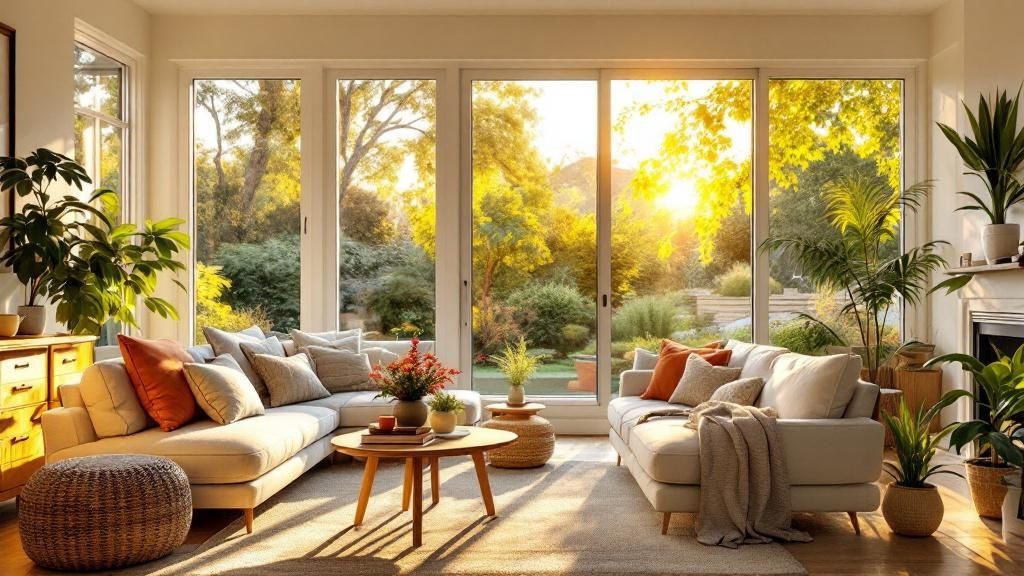
When planning a Bay Area window replacement, the first question is almost always about cost. In a high-price market like ours, you can’t rely on generic online calculators. To budget properly, you need to understand where every dollar goes.
The final price tag is a blend of your choices in materials, style, and installation complexity. It even depends on which part of the Bay Area you call home.
Key Factors Driving Your Window Budget
The total cost isn't just the price of the window. It’s a mix of interconnected factors. Getting a handle on them will help you balance quality, performance, and price.
According to a recent national survey, the average cost to replace one window is about $554, but the typical range is $338 to $897. That wide spread shows how much your choices matter. The same study found that nearly 43% of homeowners replaced windows to save on future energy bills, underscoring the importance of performance.
Material and Style: The Biggest Cost Drivers
The material you choose for your window frames will have the biggest impact on your budget. Vinyl is generally the most wallet-friendly, while premium wood or fiberglass sits at the higher end. Each offers a different mix of looks, longevity, and insulation.
The style of the window is a close second. A simple, fixed picture window will cost less than a crank-out casement or a large bay window. The more complex the design, the more you can expect to invest.
- Vinyl Windows: Usually the most affordable option, offering solid energy performance and low maintenance.
- Fiberglass Windows: A mid-to-high-range choice that’s incredibly durable and stands up to the Bay Area's temperature swings without warping.
- Wood Windows: The premium pick, loved for its classic beauty—a must-have for many historic homes in San Francisco or Berkeley.
- Aluminum Windows: Prized for slim, modern frames and often used in contemporary homes to maximize views.
For a deeper look at how these materials impact thermal performance, check out our guide on choosing energy-efficient windows.
Retrofit vs. Full-Frame Installation
The next major cost factor is how the window is installed. Your contractor will recommend one of two methods, and they have very different labor and material costs.
- Retrofit (or Insert) Replacement: This is the quicker, less invasive, and more affordable route. The new window fits inside the existing window frame. It’s a fantastic solution as long as your current frame is square, level, and free of rot.
- Full-Frame Replacement: This is a more involved job where the entire window, frame, and trim are removed down to the studs. It's the right call when there's hidden damage like wood rot or if you want to change the window opening's size or shape.
Hidden Costs to Keep in Mind
A few costs go beyond the window and installation labor. Don’t forget about permit fees, which vary from city to city—Oakland's process is different from San Jose's.
You also never know what’s hiding behind the old trim. If your contractor discovers wood rot or other structural issues, those repairs will add to the final bill. For professionals, mastering accurate job costing is what separates the pros from amateurs, ensuring a comprehensive quote without surprises.
Choosing the Best Window Materials for the Bay Area Climate
The Bay Area isn't one climate; it’s a collection of microclimates. You have salty, damp air in San Francisco and intense sun in the East Bay. This variety puts unique strain on your home, and your window frames are on the front line.
Choosing the right material is critical. It's the difference between windows that perform for decades and ones that lead to drafts, energy loss, and maintenance headaches. The material for a Bay Area window replacement has to be tough enough for our specific environmental challenges.
Matching Materials to Bay Area Needs
Your main options for window frames are wood, fiberglass, vinyl, and aluminum. Each brings something different, and the best choice depends on your home’s style, budget, and location. It's a balance of durability, insulation, aesthetics, and long-term value.
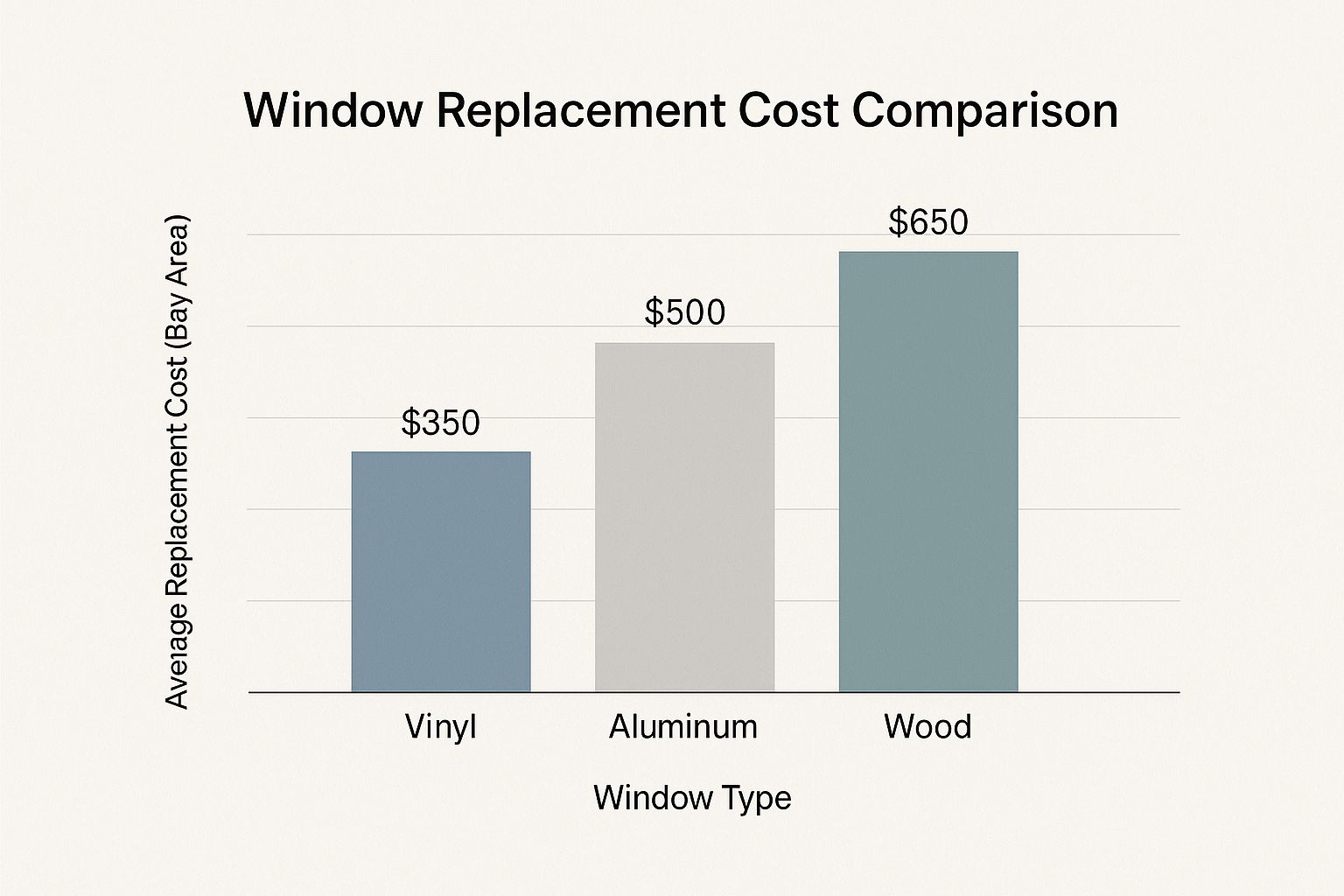
This chart gives you a sense of how materials affect your project's bottom line. Vinyl is often the most budget-friendly, while wood has a higher initial price. Let's break down the most common materials we see in homes from Berkeley to Oakland and beyond.
Window Material Comparison for Bay Area Homes
| Material | Pros | Cons | Best For |
| :— | :— | :— |
| Wood | Unmatched natural beauty, excellent insulator, highly customizable. | Higher initial cost, requires maintenance unless clad with a protective exterior. | Historic homes (Craftsman, Victorian), high-end custom builds, and homeowners prioritizing authentic aesthetics. |
| Fiberglass | Extremely durable and strong, minimal expansion/contraction, low maintenance, paintable. | Higher cost than vinyl, fewer color options than other materials. | Any home where long-term durability and performance are the top priority; great for coastal areas. |
| Vinyl | Affordable, excellent moisture resistance, virtually maintenance-free, good energy efficiency. | Less rigid than other materials, limited color choices (usually white/tan), can't be painted. | Budget-conscious renovations, rental properties, and situations where low maintenance is key. |
| Aluminum | Slim, modern frames, very strong, allows for large glass areas, durable finish. | Less insulating than other options (even when thermally broken), can be prone to condensation. | Modern and mid-century homes (like Eichlers), contemporary designs that maximize views and light. |
The right material is the one that best fits your home's needs and your personal priorities.
Wood Windows: Timeless Appeal
There's a reason wood windows have been around forever—nothing matches their classic, warm aesthetic. They are often the best choice for preserving the architectural soul of historic homes, from charming Berkeley Craftsman bungalows to stately Victorians in San Francisco. Modern wood windows from brands like Marvin feature tough exterior cladding and advanced treatments, combining beauty with durability.
Fiberglass Windows: The Durability Champion
Fiberglass is the unsung hero of the window world. Contractors love it because it's incredibly strong and stable. Made from glass fibers, it expands and contracts at almost the same rate as the windowpane itself, which is a huge deal in the Bay Area's swinging temperatures. That stability means fiberglass frames won't warp, crack, or swell.
Vinyl Windows: The Practical Choice
Vinyl windows deliver a fantastic combination of energy efficiency, low maintenance, and affordability. Made from PVC, these windows don’t mind moisture, making them a smart fit for foggy coastal areas. They never need painting or staining, which is a major plus for anyone tired of upkeep.
Aluminum Windows: Sleek and Modern
Aluminum windows are all about clean lines and impressive strength. Their slim frames can support huge panes of glass, a signature feature of modern and mid-century architecture—including the many Eichler homes across the Bay Area. Today's "thermally broken" designs have a special barrier that dramatically cuts down on energy transfer, solving the heat loss issues of older aluminum frames.
For more details on leading brands, explore a comprehensive guide to window and door brands at Truitt & White.
Navigating Bay Area Energy Codes: Title 24 Explained
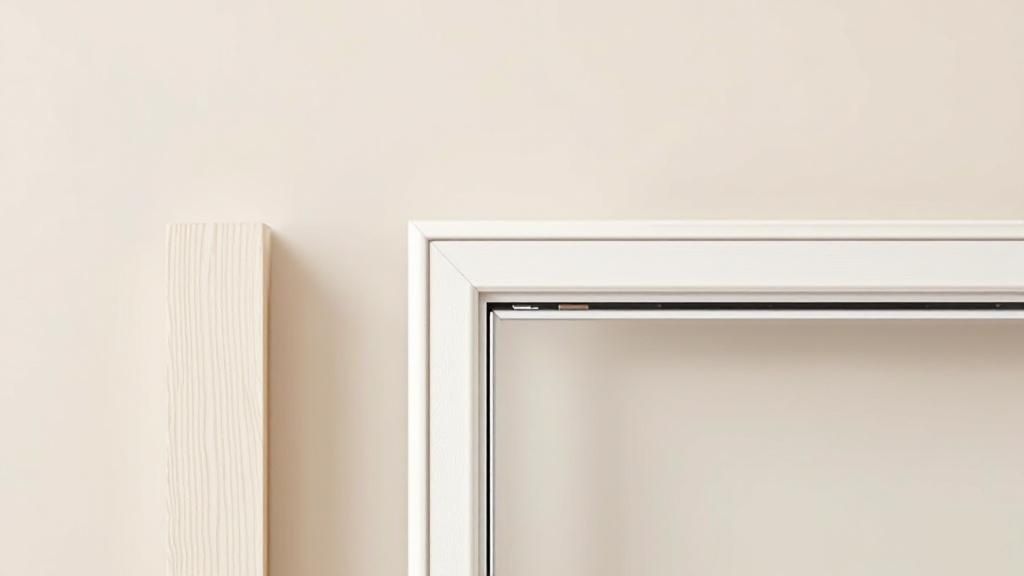
In California, energy efficiency isn’t just a nice-to-have; it’s the law. When planning a Bay Area window replacement, you are legally required to meet specific performance standards. These rules ensure our homes are more comfortable and sustainable.
The main regulation is California's Title 24, Part 6 of the Building Energy Efficiency Standards. Think of Title 24 as the official rulebook for a home's energy performance. For windows, it sets minimum requirements to ensure they help conserve energy, which takes pressure off your heating and cooling systems. Following these codes is not optional for permitted projects in cities like Oakland, Berkeley, and San Francisco.
Decoding Window Performance Labels
When you shop for a modern window, you’ll notice an NFRC (National Fenestration Rating Council) sticker with key ratings. Understanding these terms is the first step to making a smart, compliant choice.
- U-Factor: This tells you how well a window stops heat from escaping. It’s all about insulation—the lower the U-Factor, the better. A low U-Factor is a must in our mixed climate.
- Solar Heat Gain Coefficient (SHGC): This measures how effectively a window blocks the sun's heat. Again, a lower SHGC number is better because it keeps your home from overheating in the summer.
According to the California Energy Commission, most Bay Area projects require a U-Factor of 0.30 or less and an SHGC of 0.23 or less. An expert at a local supplier like Truitt & White can confirm the specific numbers for your project's location.
The Role of ENERGY STAR®
While Title 24 sets the mandatory baseline, the ENERGY STAR program helps you find windows that go above and beyond. A window that is ENERGY STAR certified for our Northern/Central California region is guaranteed to meet or exceed local energy codes.
Think of it this way: Title 24 is the passing grade, while ENERGY STAR is the honor roll. Choosing an ENERGY STAR product is the easiest way to ensure compliance and get a high-performing window. You can learn more in our guide on how to choose the right energy-efficient windows for Bay Area homes.
A Step-by-Step Guide to the Window Replacement Process
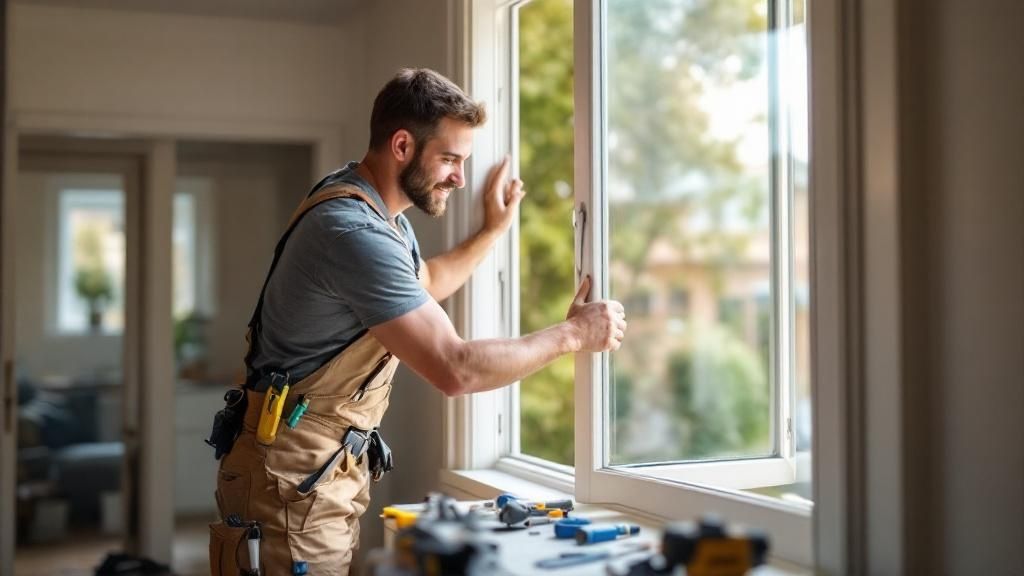
A Bay Area window replacement isn’t a single event—it’s a journey with several key milestones. Understanding the roadmap from start to finish demystifies the process, whether you're a contractor managing the job or a homeowner investing in an upgrade. A well-managed process ensures the windows you choose will perform as promised for years.
Step 1: Consultation and Measurement
Every successful project kicks off with a solid consultation with a window expert. This is your chance to discuss project goals, budget, material preferences, and any unique challenges. Soon after, an experienced pro will measure each opening meticulously to guarantee a perfect fit and prevent costly ordering mistakes.
Step 2: Product Selection and Ordering
With exact measurements, it’s time to pick your products. Visiting a showroom like Truitt & White’s allows you to see and operate different models from brands like Marvin or Andersen. Once you lock in your decisions, the order is placed, and a great supplier will double-check every detail for accuracy and code compliance. Explore all the possibilities in our The Complete Window and Door Replacement Guide.
Step 3: Installation Day
On installation day, a professional crew follows a structured plan. The workflow differs slightly for retrofit versus full-frame replacement.
For a retrofit (insert) installation:
- Site Prep: The crew lays down drop cloths to keep your home tidy.
- Old Window Removal: The old sashes are removed, leaving the original frame intact.
- Frame Check: The existing frame is inspected and cleaned.
- Setting the New Window: The new unit is placed, shimmed until perfectly plumb and level, and secured.
- Sealing and Finishing: High-quality sealant is applied around the exterior, and interior trim is finished.
For a full-frame installation:
This approach is more involved, as the entire window—frame and all—is removed down to the rough opening. This method is the gold standard, as it lets the crew inspect the home’s structure, install modern flashing, and fully insulate the gap between the new window and the house. It's the most thorough and durable installation you can get.
Finding the Right Partner for Your Window Project
The success of your Bay Area window replacement hinges on the team you hire. Finding an established, local building materials supplier isn't just a good idea—it’s the most important decision you'll make. A great partner provides critical guidance from start to finish.
This is why visiting a physical showroom is so important. When you can see and operate window models from top brands like Marvin and Andersen in a Berkeley lumberyard, you get a real feel for quality that a digital catalog can’t replicate.
The Value of Local Expertise
A seasoned local team offers advice tailored to the Bay Area. Their support is invaluable in several key areas:
- Navigating Local Codes: An expert can cut through the confusion of Title 24 requirements, whether your project is in Oakland, San Francisco, or another part of the Bay.
- Architectural Matching: They have the experience to guide you toward materials and styles that complement your home’s character, from a historic Craftsman to a classic Eichler.
- Flawless Logistics: A great supplier handles all behind-the-scenes work, coordinating orders and deliveries to ensure everything shows up on time.
When vetting a company, pay attention to communication. A partner with effective customer communication strategies can make all the difference. In an evolving market, partnering with a stable, knowledgeable supplier means you have a reliable source for high-quality products. You can read the full market study to learn more.
To get your project started on the right foot, visit our Berkeley showroom for expert advice and see the difference a true partner can make.
Frequently Asked Questions About Bay Area Window Replacement
1. How long does a typical window replacement project take?
A single window replacement can take just a few hours. A full-house installation typically takes two to five days on-site. However, the biggest factor is the manufacturing lead time for custom windows, which can be several weeks, so it's important to plan ahead.
2. Do I need a permit for window replacement in Berkeley or Oakland?
Most of the time, yes. If you are changing the size of the window opening (a full-frame replacement), cities like Berkeley, Oakland, and San Francisco almost always require a building permit. For simple insert replacements, the rules may be more relaxed, but it's always best to check with your local building department.
3. What are the best window styles for historic Bay Area homes?
For historic homes like Victorians or Craftsman bungalows, preserving architectural character is key. Double-hung wood windows are the gold standard for authenticity. Modern brands like Marvin offer historically accurate designs with advanced energy efficiency, so you don't have to compromise.
4. Can new windows really lower my PG&E bill?
Absolutely. The U.S. Department of Energy states that windows account for 25-30% of a home’s heating and cooling energy use. Upgrading from old, single-pane windows to modern, high-performance units drastically cuts down on this energy waste, leading to noticeable savings on your monthly PG&E bill.
5. What is the difference between retrofit and full-frame replacement?
A retrofit (or insert) replacement involves installing a new window into the existing frame, which is faster and more affordable. A full-frame replacement means removing the entire window unit down to the studs, allowing for new flashing and insulation; this is ideal if the old frame is damaged or you want to change the window's size.
Ready to take the next step in your window replacement project? The experts at Truitt & White are here to help you select the perfect products and navigate the process with confidence. To learn more or to determine if an upgrade is right for your property, read our guide on the thirteen signs it's time to replace your windows and doors. Visit our Berkeley showroom for expert advice.



